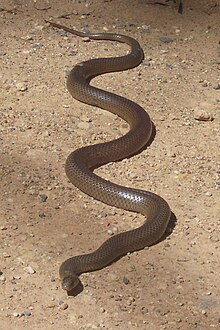Eastern brown snake
| Eastern brown snake | ||||||||||||
|---|---|---|---|---|---|---|---|---|---|---|---|---|

Eastern brown snake ( Pseudonaja textilis ) |
||||||||||||
| Systematics | ||||||||||||
|
||||||||||||
| Scientific name | ||||||||||||
| Pseudonaja textilis | ||||||||||||
| ( Duméril , Bibron & Duméril , 1854) |
The Eastern Brown snake ( pseudo Well textilis ), also Common Brown snake or Eastern Brown Otter , is in Australia and New Guinea occurring poison snake from the kind of pseudonaja ( pseudo Well ). Measured by its LD 50 value , it is the second most poisonous land snake in the world after the inland taipan, which is also native to Australia .
Occurrence
It is distributed almost all over Australia and can be found there in New South Wales , Queensland , the Northern Territories , South Australia , Victoria and Western Australia . The poisonous snake also populates New Guinea, north of Australia .
features
anatomy
The eastern brown snake becomes about 1.5 m long. However, some individuals have been shown to reach a length of up to 2.4 m, which means that the species can be counted among the large among the elapids . It is slim, but built a little wider than other species of its genus and has a rounded head.
coloring
When fully grown, it is usually light brown to dark brown in color, although the color varies greatly and there are also black-colored specimens.
behavior
The eastern brown snake is considered to be very dangerous, as it reacts very nervously and aggressively when it comes to encounters, which results in frequent biting. It twists its body into an S-shape and then bites extremely quickly and usually several times (four to five times) in order to inject the maximum amount of poison .
Poisonous effect
The poison of the eastern brown snake is extremely effective - the LD 50 value for mice is 0.041 mg per kilogram of body weight, making it one of the most effective poisons known to affect snakes.
- Haemotoxic effect
The toxin mainly includes the protein textarin, which is derived from the Latin name of the snake. This component activates the prothrombin and converts it into thrombin , which is one of the most important processes for blood clotting . It also inhibits the protein plasmin and thus prevents the blood clots from dissolving . This results in a so-called consumption coagulopathy , since all coagulation factors are so heavily used that the blood can then almost not coagulate.
- Neurotoxic effect
The neurotoxic part of the poison has the effect that the release of acetylcholine , which is an important neurotransmitter , is completely stopped. This leads from a disturbance to the inhibition of the electrical stimulus propagation from the nerves to the muscles, with the result of a neuromuscular blockade (muscle paralysis).
